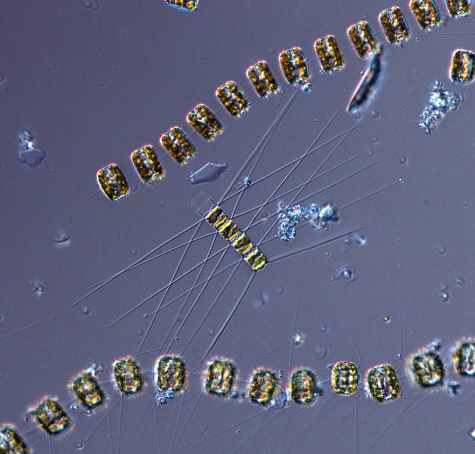


|
 |
Synonym(s)
*Sometimes referred to as C. simile (Guiry 2012).
Classification
(Guiry and Guiry 2012)
Lifestyle
Description
Valve
In diatoms, the structurally distinct halves of the cell wall (Becker 1996).
Valves have a raised centre where adjacent cells touch, which, together with the spines, form a distinct figure-eight-shaped CloseAperture
"In some diatoms, the space between the valves of adjacent cells in chains" (Horner 2002).
aperture. Spines are very straight and arise from the corners of the cell, crossing just outside the cells then extending out diagonally. Terminal spines are similar but may be slightly thicker. A small but distinct groove is present between the valves and the CloseGirdle
In diatoms, the portion of the cell wall between the two valves of a cell; made up of intercalary bands (bands closest to the valves) and connecting bands (bands in the middle of the girdle). In dinoflagellates, the equivalent of a cingulum or transverse furrow (Horner 2002).
girdle zone. Cells each have two chloroplasts (Cupp 1943). Cells are yellow-brown in colour.Spicules
Small, needlelike structures.
spicules (Cupp 1943).Measurements
Apical
(axis, spine) The region of the apex or point. Refers to the most anterior point or region of the cell (HPP 2003).
(apical axis): 7 - 17 μm(Hasle and Syvertsen 1997)
Similar species
Harmful effects
Habitat
Distribution
Temperate to cold waters (Hasle and Syvertsen 1997).
(See Local).
Found from late spring to early summer in Saanich Inlet, BC (McQuoid and Hobson 1995). Present off California, but never in large numbers (Cupp 1943).
Growth conditions
Photoperiod
The amount of time in a day that an organism is exposed to daylight. This varies between seasons, with photoperiods being longer in the summer and shorter in the winter.
photoperiods around 16 h (McQuoid and Hobson 1995).Environmental Ranges
Temperature range (°C): -1.383 - 24.625
Nitrate (μmol L-1): 0.567 - 14.229
Salinity: 17.940 - 35.659
Oxygen (mL L-1): 4.855 - 8.936
Phosphate (μmol L-1): 0.152 - 1.370
Close
Silicic acid
A general term to describe chemical compounds containing silicon, oxygen and hydrogen with a general formula of [SiOx(OH)4-2x]n. Diatoms polymerize silicic acid into biogenic silica to form their frustules (Azam and Chisholm 1976).
Silicate (μmol L-1): 1.309 - 35.210(OBIS 2012, cited in EOL 2012)
Bloom characteristics
References
Cupp, E. E. 1943. Marine Plankton Diatoms of the West Coast of North America. University of California Press. Berkeley, California. 238.
Encyclopedia of Life (EOL). 2012. Chaetoceros similis. http://eol.org/pages/2540183/overview. Accessed 31 Mar 2012.
Guiry, M. D. 2012. Chaetoceros similis Cleve, 1896. http://www.marinespecies.org/aphia.php?p=taxdetails&id=149127. Accessed 31 Mar 2012.
Guiry, M. D. and Guiry, G. M. 2012. Chaetoceros similis Cleve. http://www.algaebase.org/search/species/detail/?species_id=37462. Accessed 31 Mar 2012.
Hasle, G. R. and Syvertsen, E. E. 1997. Marine diatoms. In: Tomas, C. R. (ed.) Identifying Marine Phytoplankton. Academic Press, Inc., San Diego. 5-385.
Horner, R. A. 2002. A Taxonomic Guide To Some Common Phytoplankton. Biopress Limited, Dorset Press, Dorchester, UK. 200.
Kraberg, A., Baumann, M. and Durselen, C. D. 2010. Coastal Phytoplankton: Photo Guide for Northern European Seas. Verlag Dr. Friedrich Pfeil, Munchen, Germany. 204.
Ocean Biogeographic Information System (OBIS). 2012. Chaetoceros similis. http://www.iobis.org/mapper/?taxon_id=419713. Accessed 31 Mar 2012.
